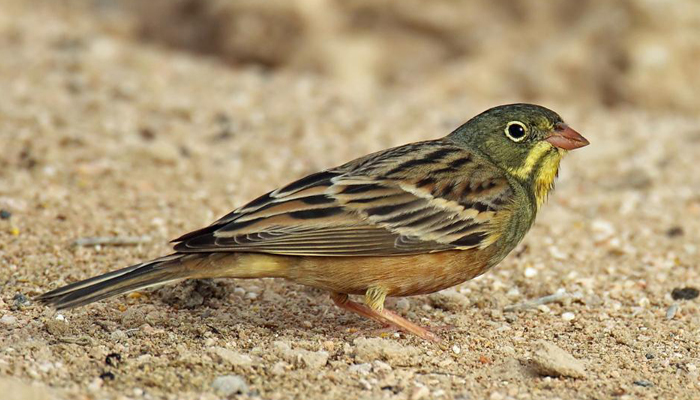
English: Ortolan Bunting
Russian: Садовая овсенка
Mongolian: Алаг хөмрөг
German: Ortolan
French: Bruant ortolan
Japanese: ズアオホオジロ (Zuao-hojiro)
Body
length: 13-14
½ cm.
Breeds at lower levels in agricultural country with some patches of trees
and deciduous copses, in open wooded pasture and in clearings, and in S Europe,
Turkey and Caucasus in mountain regions, usually in glades or at forest edge
above 1500 m. Summer visitor (mainly Apr-Set), winters in tropical Africa.
Nocturnal migrant. Forages mostly on ground, often on dry, short-grazed grassy
areas. Rather shy and wary, quick to take cover.
Identification:
Medium-sized, slim bunting. Bill rather long. Legs and bill buffish-pink,
culmen a shade darker and with straight profile. Yellowish-white eyering in all
plumages, as well as heavily dark-streaked grey-brown mantle and dark lateral
throut stripe on light yellow ground (juv. Lacks yellow upto Jul/Aug). Flanks
and belly have variable distinct orange-brown tone (except juv.), and head and
nape are usually olive-toned. Rump grey-brown and streaked.
- ♂ summer: Head,
broad breast-band and narrow lateral throat stripe plain olive-grey; belly and
flanks saturated orange-brown.
- ♀ summer/adult autumn: Crown, breast and lateral
throat stripe finely dark-spotted. Olive-grey breast-band narrow or indistinct;
orange colour below sometimes weaker. Some ♂♂ have unspotted olive-grey breast-band as in summer.
- 1st winter: Head
brown-grey (without green tinge) and boldly streaked; lateral throat stripe,
breast and upper flanks heavily streaked. Eye-ring buffish-white. Throat light
buffy-yellow.